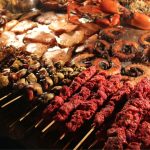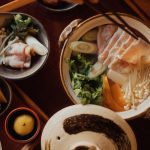Table of Contents
Steam rises from sizzling pans as neon signs paint the night sky in electric colors. Welcome to the night markets of Taiwan, where every alley tells a story through aroma and taste.
When Night Comes Alive
Taiwan’s night markets aren’t just places to eat – they’re living museums of street food culture. Each market springs to life around sunset, usually 4 PM, and pulses with energy until midnight. The sweet spot? 7-9 PM, when the energy peaks but the crowds haven’t reached their maximum.
The Big Names You Can’t-Miss
Shilin Night Market in Taipei stands as the grandfather of them all. Sprawling across several city blocks, it’s famous for its XXL fried chicken cutlets and underground food court. But don’t rush straight to the food – the outer streets hold treasures like handmade bubble tea and traditional clay-oven baked pepper buns.
Raohe Street Night Market offers a more concentrated experience. One long street packed with generations-old food stalls. Start at the Songshan Ciyou Temple entrance – the pepper buns here inspire hour-long queues for good reason.
Hidden Gems That Locals Love
Skip the tourist-heavy spots and head to Ningxia Night Market. Smaller, more focused on food than souvenirs, and beloved by Taipei residents. The oyster omelets here set the standard for the entire city.
Huaxi Street Night Market, once known as Snake Alley, has transformed into a fascinating mix of traditional and modern Taiwan. While the snake soup vendors have largely disappeared, the market’s character remains uniquely atmospheric.
Must-Try Street Foods
Every night market has its stars:
- Stinky tofu: Don’t let the smell scare you. The fermented tofu, when properly fried and topped with pickled cabbage, offers complex flavors that might make it your surprise favorite.
- Gua bao: Often called Taiwanese hamburgers, these fluffy steamed buns filled with braised pork, crushed peanuts, and cilantro represent street food perfection.
- Oyster vermicelli: A humble bowl of thin noodles in a rich, flavorful broth with fresh oysters. Look for stalls with long lines of locals.
Local Secrets and Survival Tips
Bring small bills and coins. Most vendors don’t accept cards, and breaking large bills can be tricky. Learn the local name for what you want to try – pointing works, but knowing “Chou dofu” for stinky tofu earns smiles and sometimes extra portions.
Watch where locals queue. Long lines usually mean something special, but check if the line is mostly tourists or locals. Tourist lines don’t always lead to the best food – just the most famous.
Navigation Know-How
Markets follow an unwritten layout code. Outer edges usually feature games and clothes, while the best food often hides in the central alleys. Don’t stick to the main paths – the narrower the alley, the more likely you’ll find something special.
Most markets cluster near MRT stations, making them easy to find. But download an offline map – the maze-like layouts can disorient even experienced visitors once you’re inside.
Beyond Food: The Full Experience
Night markets started as temple fairs, and many still connect to Taiwan’s spiritual life. Notice the small shrines tucked between stalls, often still tended by vendors. These glimpses into local life tell stories that tourist guides miss.
Try your hand at carnival games. Ring toss, balloon darts, and fishing games offer prizes and a chance to join in local fun. Watch others play first to learn the tricks – some games have techniques passed down through generations.
Market by Market Breakdown
Each market has its specialty:
- Keelung Night Market: Seafood heaven, especially their thick crab soup
- Feng Chia Night Market: Modern street food innovations and youth culture
- Tainan Flower Night Market: Traditional Southern Taiwanese flavors
- Luodong Night Market: Famous for its sweet and savory sausages
Timing Your Visit Right
Weekday evenings see fewer crowds but also fewer open stalls. Weekends bring full energy but require patience with queues. Rain doesn’t stop the markets – many stalls have covered seating, and fewer tourists mean shorter lines.
Cultural Etiquette Tips
Taiwanese queue culture is serious business. Never cut lines, and don’t save spots for large groups. When sharing tables (a common practice), a quick nod to others already seated shows respect.
Bargaining isn’t common for food but is expected for goods. Start at 70% of the asking price and work up. But remember – aggressive bargaining over small amounts can seem disrespectful.
Photography Protocol
Most vendors don’t mind photos but ask before taking close-ups, especially of cooking processes. Some have secret recipes they protect. Buying something first usually earns you photography privileges.
Smart Money Moves
Budget around NT$300-500 for a full evening of snacking. While individual items cost NT$30-100, trying everything adds up. Some vendors now accept LINE Pay or other digital payments, but cash remains king.
Stay Safe and Healthy
Choose busy stalls where food moves quickly. Fresh oil looks clear, not dark. Watch for the QR codes that show food safety certifications – a recent government initiative that top vendors proudly display.
Carry water and know where bathrooms are – most markets have public facilities, but convenience stores offer cleaner options. Many markets now provide hand sanitizing stations at major entrances.
Environmental Awareness
Modern markets encourage sustainability. Bring reusable chopsticks and a handkerchief to wipe your hands. Some markets even offer rewards for bringing your containers, though street food’s traditional paper packaging is part of the experience.
The night market scene evolves, mixing traditional with modern consciousness. Your visit supports a centuries-old culture while it adapts to contemporary needs.
Seasonal Specialties
Each season brings unique offerings to night markets:
- Spring: Mango shaved ice makes its first appearance, and fresh spring rolls feature seasonal vegetables
- Summer: Ice-cold aiyu jelly drinks and papaya milk become essential refreshments
- Fall: Sweet potato balls and roasted chestnuts in warm chilly evenings
- Winter: Steaming hot pot stalls expand their seating, and ginger tea vendors appear
Language Bridge
While many vendors speak basic English, learning a few phrases opens doors:
- “Hao chi” (Good eating) – say this after receiving your food.
- “Duo shao qian?” (How much?) – for asking prices
- “Yi ge” (One portion) – basic ordering
- “La” (Spicy) – add this if you want heat, “Bu la” for no spice.
Remember, enthusiasm and respect transcend language barriers. A smile and genuine interest in their craft often lead to generous portions and cooking tips from veteran vendors.
A Feast for All Senses
Taiwan’s night markets capture something rare in today’s world – places where food, culture, and community still intertwine naturally under the glow of paper lanterns. Every steaming dumpling and sizzling grill tells a story decades in the making. These markets aren’t just dinner stops; they’re living proof that some traditions only get better with time.

I’m Garrett, a seasoned photojournalist with a passion for uncovering the world’s hidden treasures. My journey is fueled by a deep curiosity for diverse cultures and breathtaking landscapes. When I’m not behind the lens capturing the world’s wonders, you can find me exploring underwater realms or sharing my passion for discovery with my two adventurous children.




